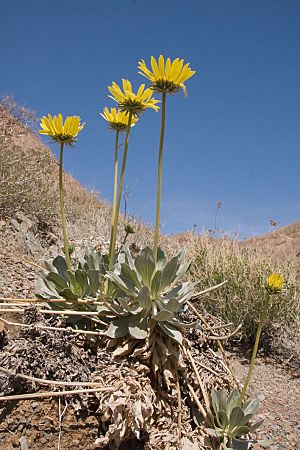Panamint daisy facts for kids
Quick facts for kids Panamint daisy |
|
|---|---|
 |
|
| Scientific classification | |
| Kingdom: | |
| (unranked): | |
| (unranked): | |
| (unranked): | |
| Order: | |
| Family: | |
| Tribe: | |
| Genus: | |
| Species: |
E. covillei
|
| Binomial name | |
| Enceliopsis covillei (A. Nelson) S.F.Blake 1931
|
|
| Synonyms | |
|
|
The Enceliopsis covillei, also known as the Panamint daisy, is a special and rare desert flower. It belongs to the daisy family, just like sunflowers and dandelions! This beautiful plant grows in the deserts of North America.
Contents
The Panamint Daisy: A Desert Survivor
The Panamint daisy is a type of perennial plant. This means it lives for more than two years. It grows from a strong, woody base called a caudex. Its stems stand tall, from about 15 to 100 centimeters (6 to 40 inches) high.
The leaves of the Panamint daisy are quite unique. They are covered in soft, silvery hairs, making them look woolly. These leaves can be up to 10 centimeters (4 inches) long and 8 centimeters (3 inches) wide. They often have interesting shapes, like a spade, an oval, or even a diamond. The leaves also have special winged stems called petioles.
What Does Its Flower Look Like?
The Panamint daisy produces a large, single flower head. This head grows on a tall stem called a peduncle, which can reach up to 100 centimeters (40 inches) tall. The base of the flower head has three layers of pointed leaves called phyllaries. These are also covered in gray or silvery hairs.
The flower head itself is very striking. It has many bright yellow ray florets around the edge. Each of these "petals" can be up to 5 centimeters (2 inches) long. In the center, there are many small yellow disc florets. After the flower blooms, it produces a small fruit called an achene. This fruit is about a centimeter long and has a tiny fluffy top called a pappus.
Where Does This Special Daisy Grow?
The Panamint daisy is an endemic plant. This means it is found only in one specific place in the world. For this daisy, that place is California. It lives inside Death Valley National Park in Inyo County. You can find it on the rocky slopes of the western Panamint Range. This area is like a "sky island" because it's a cooler, wetter spot in the middle of the hot, dry Mojave Desert.
The plant was named after an American botanist, Frederick Vernon Coville (1867–1937). Another botanist, Aven Nelson, gave it the name Helianthella covillei in his honor.
Why Is the Panamint Daisy Important?
The Panamint daisy is considered an endangered species. This means it is at risk of disappearing forever. Because it is so rare, people are working to protect it.
An image of the Panamint daisy is even featured in the logo of the California Native Plant Society. This group was started in 1965. They work hard to study, protect, and teach people about California's native plants. The society lists the Panamint daisy on its Inventory of Rare and Endangered Plants. This shows how important it is to keep this unique desert flower safe.

